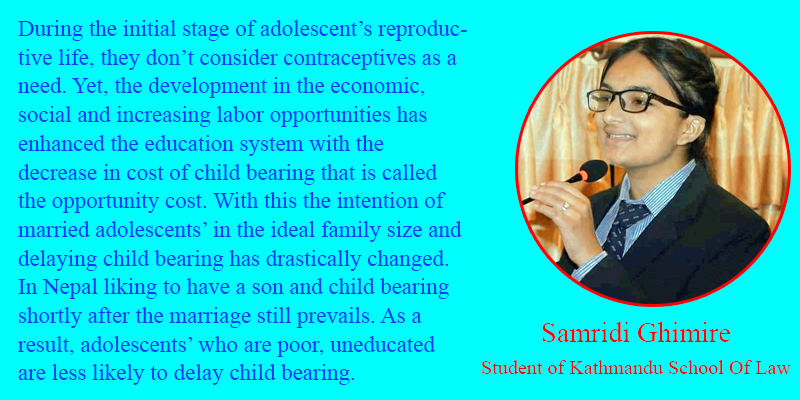
In Nepal early marriage and early motherhood places adolescents in an unfavorable circumstances. There is a high risk on health of both baby and mother during the time of childbirth. Most of the adolescents are from a poor family background, lack of sex education, non users of contraceptives, having unplanned pregnancy and done with several times unsafe abortions. In 1959, Nepal’s first Family Planning Program was started by Family Planning Association of Nepal. The national governmental supported program was not launched until the later part of 1968. In the initial stage the national family planning was introduced only in the cities of Kathmandu Valley.
Delaying the first birth and ensuring the healthy birth intervals among adolescents is a central mechanism to a healthy and productive life and that’s the reason why the Government adopted a family planning policy as a means of maintaining a balance between population growth and economic growth. Delaying child bearing even for a year or a two, could prevent premature maternal and neonatal mortality and also giving adolescents girls to empower, explore and experience themselves for the benefit of them and the whole country itself.
Lower use of contraceptives is also a persistent and serious problem in Nepal. Adolescents demand for the contraceptives use was not met and was a serious problem to be encountered. It is very important to note that married adolescents are increasingly engaging in sexual actitivity which can lead to serious problem like the risk of contracting STI (sexually transmitted disease).
Later in 1966, Clinics in Kathmandu valley were started and training of physicians in IUD insertions was being conducted. In 1967, The M.C.H Family planning section expanded its manpower, paramedical training activities and its provision of services inside and outside Kathmandu Valley. In 1968, Nepal’s government supported family planning service delivery program was established.
In 1970, the total cost of family planning service delivery by the four main agencies increased by US$ 0.4 million. In 1975, the population Policy Coordination Board was established under the National Planning Commission. In 1976, 6% of currently married women knew where to get modern contraceptives. In 1978, Nepal Contraceptive Retail Sales Company, NCRSC was first established. In 1981, 33% of currently married women knew where to get modern contraceptives. In 1982, the total cost of family planning service delivery by the four main agencies increased by US$ 2 million. In 1986, he total cost of family planning service delivery by the four main agencies was fivefold increased in real cost. In 1987, Government of Nepal undertook a bold step by rearranging the structure of the National Health and Family Planning Systems.
During the initial stage of adolescent’s reproductive life, they don’t consider contraceptives as a need. Yet, the development in the economic, social and increasing labor opportunities has enhanced the education system with the decrease in cost of child bearing that is called the opportunity cost. With this the intention of married adolescents’ in the ideal family size and delaying child bearing has drastically changed. In Nepal liking to have a son and child bearing shortly after the marriage still prevails. As a result, adolescents’ who are poor, uneducated are less likely to delay child bearing.
Adolescent’s intentions on child bearing also differ with the ethnic groups. The study has shown more than half of married adolescents’ girls from Brahmin, chettri and janjati prefer to delay child bearing where as Dalits and Muslims community prefer early child bearing. It also differs from regional perspectives. Adolescent girls who are from mountain region prefer to delay child bearing and child bearing gap delay after their first child as well. While in Terai region, due to different circumstances the communities follow more traditional behaviors regarding marriage and child formation. We can take example of Dowry, cross border marriage etc.
There is also a lower use in contraceptives by adolescents’ due to the lack of knowledge, awareness, and misconceptions. They have a fear with misconception of side effects and negative impact on fertility and one’s health as well. In Nepal, like other countries are aware at least about the modern child spacing methods like condoms, pills, injections and emergency contraceptives. Nepali woman lacks the practical knowledge about methods, characteristics, effectiveness, source to obtain and awareness of side effects. Users of contraceptives also appear to have incomplete knowledge about methods and efficiency.
Nepal is a country where husband tends to be the sole decision maker regarding the contraception and pregnancy in marriage. Nepali Adolescents have low decision making power about marriages, pregnancy, reproductive health, child bearing and so on. Not only husband but also family members tend to force for early marriage, early child bearing and do not care about the reproductive health and issues that may arise as a consequence. A large age gap between the couples and arrange marriage, dowry practices, where women are likely to suffer from domestic violence very after their first sexual experience. This is a serious problem that brings serious consequences in the reproductive health of adolescent girls.
Family planning is the key priority for Government of Nepal. The first thing is to empower girls with the practical knowledge of contraception and reducing the misconceptions about the side effects on health as well. Girls need to be empowered by giving them pure knowledge and teaching life skills. Ensuring outreach counseling and contraceptives distribution among married woman’s that can result in the higher use of contraceptives use and discussion among the young and adolescent girls. Monitoring and evaluating should be done by health staffs that is trained and qualified one. One should design innovative way of contraceptives delivery modalities through training and distribution in the private outlets as well.
Leave a Reply